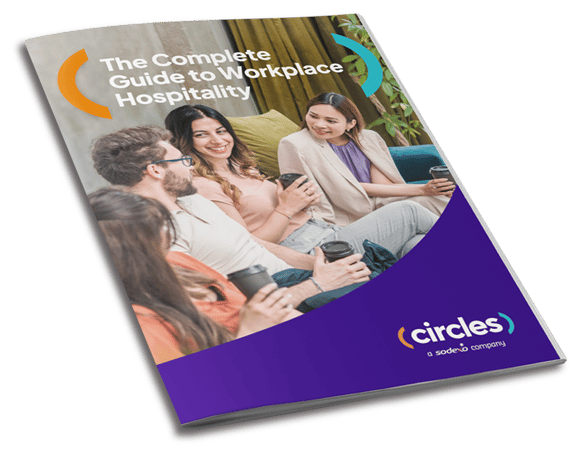
Free eBook
The Complete Guide to Workplace Hospitality
The "go-to" guide for creating a workplace experience where employees feel welcomed, valued and inspired every day.
This eBook covers the trending workplace strategy of "hotelification" with key insights and actionable strategies including:
-
The evolving workplace landscape and key challenges organizations are facing, including return-to-office (RTO), productivity, employee engagement and technology
-
When and how to use workplace hospitality — “hotelification” — as an employee experience strategy to solve business challenges
-
How a workplace hospitality strategy delivers value for facilities and building managers
-
Workplace hospitality examples in action
-
How to measure the impact of workplace hospitality
See how putting a workplace hospitality strategy into place creates an environment where employees want to be, not have to be. Download the Complete Guide to Workplace Hospitality, today!

Here's a preview of what's inside:
Chapter 1: The Evolving Workplace Landscape

The prevalence of hybrid and remote work arrangements continues to influence how organizational leaders approach nearly every aspect of work — from compensation and benefits to culture-building initiatives and beyond. According to Gallup research, 80% of employees report hybrid or remote is their permanent work arrangement now. This means organizations need to do (and offer) more to inspire employees to want to come into the office, whether that’s for a few days a week or on another schedule.
Because hybrid work has so quickly become the norm, organizations still grapple with many of the growing pains that emerged with the shift. Managers of hybrid teams — and especially newer managers who may have less leadership training — face a number of unique challenges due to working with dispersed teams.
Three key challenges associated with hybrid work arrangements:
Connection Challenges
While overall employee engagement rates are up slightly, fully remote workers feel increasingly disconnected from their employer’s mission and values, according to Gallup. Hybrid employees, on the other hand, cite socialization and collaboration as top reasons for visiting the workplace. Learn more about the importance of comfortable, thriving community spaces in our eBook: Creating the Workplace of the Future.
Productivity
Organizational leaders continue to worry about the productivity of employees working from somewhere other than the office. A variety of studies have attempted to shed light on this issue but they have been largely inconclusive. That said, remote workers often report being more productive and also less likely to quit. Even so, leaders often lack confidence in this area.
Technology
Hybrid work teams may experience more and different technical challenges, compared with in-office teams. It can feel like everyone needs to be their own IT department now.
Find out more: Get the full 21-page Complete Guide to Workplace Hospitality

In addition to the various challenges that stem from employees working outside the office, there are numerous opportunities for organizations to take initiative, address employees’ needs and position the company for success.

Facilitate Better Workplace Socialization
The Society of Human Resource Management (SHRM) reports 70% of employees aren’t able to socialize enough when they’re working remotely. This suggests organizations can prioritize social connection in the (physical) workplace as a way to make the office a more appealing place to work. Among employees enjoying the flexibility of a hybrid work arrangement, 39% said the workplace becomes a hub for social interaction.

Improve Quantity and Quality of Talent Attraction
Job seekers are taking work culture and the employee experience into consideration perhaps more than ever before. Leveraging your company’s workplace hospitality programs and practices can be an effective way to differentiate your organization from competing employers.

Enhance the Employee Experience to Reduce Turnover
Workplace hospitality creates memorable impressions and fosters loyalty. It’s a strategy that keeps employees in their seats and reduces turnover. While overall turnover is relatively low at 3.8% (average for 2023, according to Forbes), many industries like healthcare and legal are struggling with rates as high as 23% and 20%, respectively.

Find Balance in the Hybrid Split
Over the past few years, employees and business leaders have not always agreed on the appropriate ratio of in-office days to remote work days. Now that the hybrid work model has been thoroughly road tested, McKinsey research found that at least two days in the office per week is the “sweet spot” for workers. “When over 50% of time is spent in-person, we see trade-offs begin to emerge,” Katy George, McKinsey’s chief people officer and a senior partner at the firm, told CNBC Make It. “Individuals and teams have less flexibility, time for recovery and opportunities to do focused work.” This tension is a key reason employers are increasingly turning to strategies like hotelification to improve the in-office work experience and better support employees’ work-life balance. (We explore the concept of hotelification further in Chapter 4 of the eBook.)

Support Business Growth
Workplace hospitality is necessary to fuel business growth. By leveraging the benefits of hospitality to drive positive customer/
employee reviews, improve customer loyalty, strengthen brand perception and competitiveness, organizations can expect
higher traffic and more trade opportunities that lead to growth.
Download the free 21-page Complete Guide to Workplace Hospitality

